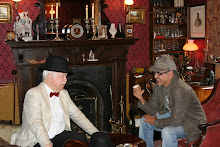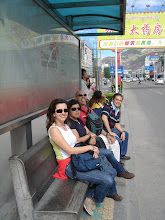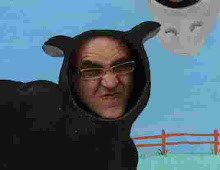Fraser Island (K'Gari), in the south limit of Great Barrier Reef, Australia
I wake early, very early, because
i want to take advantage of what the day offers. Put my shoes on, grab my canon
and the GoPro, throw them inside my bagpack and run into the harbour to take
another boat, this time to Fraser Island, a Island that lives under the
aboriginal culture lores, giving a breath of adventure that my soul truly
enjoys. Located 300 km north from Brisbane, the island is more than 1800km2,
the biggest sandy Island in the world, with its infinite dune system and
subterraneous water creeks that feed rivers and more than 200 lakes of sweet
water. The result is that despite the sandy nature of the local ground the
cover of the Island is dense and green, making it a very unusual place. As a
consequence, Unesco declared it as World Heritage in 1992.
The 'Butchulla' people would
originally name the Island, 'K'Gari' - a fitting name they gave this tranquil
place that means 'paradise'. Most of today's history suggests that
"K'Gari" was occupied by the 'Butchulla' people for five thousand
years, and some even say that it was much longer at around twenty thousand
years. There was a permanent population of 400–600 that grew to 2,000–3,000 in
the winter months due to abundant seafood resources. The arrival of European
settlers in the area was an overwhelming disaster for the Badtjala people.
European settlement in the 1840s overwhelmed the Aboriginal lifestyle with
weapons, disease and lack of food. By the year 1890, Aboriginal numbers had
been reduced to only 300 people. Most of the remaining Aborigines, the Badtjala
tribe, left the island in 1904 as they were relocated to missions in Yarrabah
and Durundur, Queensland. It is estimated that up to 500 indigenous
archaeological sites are located on the Island. In October 2014, Native title
rights were granted to the Badtjala people by the Federal Court. This
essentially enabled the indigenous people to hunt, fish and take water for
domestic purposes and could open the island up to economic opportunities for
current and future generations of Butchulla people through ecotourism and
related business development.
The actual name Fraser Island
comes from Eliza Fraser and her story of survival from a shipwreck on the
island. Captain James Fraser and his wife, Eliza Fraser, were shipwrecked on
the island in 1836. The ship was holed on coral while travelling through the
Great Barrier Reef. During the trip in the
lifeboats, Captain Fraser's pregnant wife gave birth in the leaking lifeboat.
The infant died soon after birth. The Captain's lifeboat was becoming more and
more unseaworthy and was soon left behind by the other lifeboat which continued
on. The sinking boat and its crew was beached on what was then known as the
Great Sandy Island. Whether the survivors died due to disease, hunger,
exhaustion or battles with the native population will never be known for sure;
most likely a little of all of the above. Captain Fraser died leaving Eliza
living among the local peoples. She was rescued 6 weeks after being shipwrecked
by a convict, John Graham,[10] who had lived in the bush as an escapee, and who
spoke the Aboriginal language. He was sent from the settlement at Moreton by
the authorities there who had heard about Eliza's plight, and negotiated her
return. Within 6 months, Eliza had married another sea captain. She moved to
England and became a sideshow attraction in Hyde Park telling ever more lurid
tales about her experiences with white slavery, cannibalism, torture and
murder. As she is known to have told several versions of the story, it is
unknown which version is the most accurate. She was killed in a carriage
accident in Melbourne in 1858.
Come along with us, blown by the themes
Enjoy the Nature and Respect then Love (the Mind Orchestra), so adequate to
Butchulla lores, tasting the flavour of this unique and sustainable spot of
nature in our planet.
Kisses & Hugs
Kisses & Hugs
Acordo cedo, muito cedo, que o dia é para aproveitar, o melhor que puder. Enfio os xanatos nos pés, rebusco a minha canon e a go pro, acondiciono-as na mochila e…toca a zarpar, de novo de barco, em direção à Fraser Island, uma ilha governada ao sabor da cultura aborígene, o que certamente me enleva a alma aventureira. Localizada 300 km ao norte de Brisbane, a Ilha Fraser tem aproximadamente 1800 km², sendo a maior ilha de areia do mundo, com infinitas dunas e um sistema de águas subterrâneas que formam rios e mais de 200 lagos de água doce, propiciando um micro-clima único na Austrália, que mesmo num solo 100% arenoso, desenvolveu uma vegetação densa, que lhe dá características únicas. Por ser um lugar tão especial, a ilha foi declarada como Patrimônio Mundial da UNESCO em 1992.
O nome original da ilha, dado pelos Butchulla (aborigenes) que habitaram ilha por mais de 5000 anos (até aos dias de hoje), era K’Gari que significa Paraiso, o que se adequa perfeitamente à sua localização e condição. A sua relação em equilíbrio com a natureza permitiu a sua preservação por longo tempo, até à chegada dos colonos europeus que, como de costume, arrasaram esse equilibrio com a exploração massiva de recursos (madeira para a construção de navios) acabando por expulsar toda a população local, em 1904. Mas como a história dá muita volta e reviravolta, os direitos dos nativos locais acabariam reconhecidos pela autoridade australiana em 2014, permitindo o seu regresso e re-estabelecimento sustentável na ilha, autorizados que estão a praticar caça e pesca de sobrevivência e utilização de água doce, bem como a exploração económica do eco-turismo
O nome actual da ilha advém da história de sobrevivência da mulher de um capitão de um navio, Eliza Fraser, que naufragou defronte da ilha em 1836, depois de rasgar o casco nos recifes de coral da Grande Barreira de Coral. Durante o resgate, Eliza deu à luz no próprio salva vidas, mas o miúdo não resistiu mais do que um par de horas e os restantes sobreviventes foram morrendo (incluindo o próprio marido e capitão do navio desgraçado) devido a doenças, fome, exaustão e quiçá em lutas com a população nativa local até que Eliza ficou sozinha entre os aborígenes. Acabaria salva, 6 semanas depois, por um foragido da justiça, de nome John Graham, que vivia entre os aborígenes e falava a sua língua. Pouco tempo depois, Eliza casava corajosamente com outro capitão de navio e regressaria a Inglaterra, onde se tornaria conhecida pela sua aventura de sobrevivência, apimentada com escravatura branca, canibalismo, tortura e homicidios contada em primeira mão e quiçá romanceada. Eliza acabaria por regressar à Australia, onde novo infortúnio lhe poria fim à vida, vítima de um acidente da carruagem em que viajava, em Melbourne em 1858.
Venham lá daí comigo, no sopro dos temas Enjoy the Nature e Respect then Love (the Mind Orchestra), tão em sintonia com os princípios dos Butchulla, saboreando este lugar único no mundo e um dos principais destinos para quem passa por aquelas bandas.
Beijos e abraços
Beijos e abraços
.jpg)





Sem comentários:
Enviar um comentário